AI-900 : Microsoft Azure AI Fundamentals : Part 02
AI-900 : Microsoft Azure AI Fundamentals : Part 02
-
DRAG DROP
Match the types of machine learning to the appropriate scenarios.
To answer, drag the appropriate machine learning type from the column on the left to its scenario on the right. Each machine learning type may be used once, more than once, or not at all.
NOTE: Each correct selection is worth one point.

AI-900 Part 02 Q01 012 Question 
AI-900 Part 02 Q01 012 Answer Explanation:
Box 1: Regression
In the most basic sense, regression refers to prediction of a numeric target.Linear regression attempts to establish a linear relationship between one or more independent variables and a numeric outcome, or dependent variable.
You use this module to define a linear regression method, and then train a model using a labeled dataset. The trained model can then be used to make predictions.
Box 2: Clustering
Clustering, in machine learning, is a method of grouping data points into similar clusters. It is also called segmentation.Over the years, many clustering algorithms have been developed. Almost all clustering algorithms use the features of individual items to find similar items. For example, you might apply clustering to find similar people by demographics. You might use clustering with text analysis to group sentences with similar topics or sentiment.
Box 3: Classification
Two-class classification provides the answer to simple two-choice questions such as Yes/No or True/False. -
DRAG DROP
Match the machine learning tasks to the appropriate scenarios.
To answer, drag the appropriate task from the column on the left to its scenario on the right. Each task may be used once, more than once, or not at all.
NOTE: Each correct selection is worth one point.

AI-900 Part 02 Q02 013 Question 
AI-900 Part 02 Q02 013 Answer Explanation:
Box 1: Model evaluation
The Model evaluation module outputs a confusion matrix showing the number of true positives, false negatives, false positives, and true negatives, as well as ROC, Precision/Recall, and Lift curves.Box 2: Feature engineering
Feature engineering is the process of using domain knowledge of the data to create features that help ML algorithms learn better. In Azure Machine Learning, scaling and normalization techniques are applied to facilitate feature engineering. Collectively, these techniques and feature engineering are referred to as featurization.Note: Often, features are created from raw data through a process of feature engineering. For example, a time stamp in itself might not be useful for modeling until the information is transformed into units of days, months, or categories that are relevant to the problem, such as holiday versus working day.
Box 3: Feature selection
In machine learning and statistics, feature selection is the process of selecting a subset of relevant, useful features to use in building an analytical model. Feature selection helps narrow the field of data to the most valuable inputs. Narrowing the field of data helps reduce noise and improve training performance. -
HOTSPOT
To complete the sentence, select the appropriate option in the answer area.

AI-900 Part 02 Q03 014 Question 
AI-900 Part 02 Q03 014 Answer -
You have the Predicted vs. True chart shown in the following exhibit.
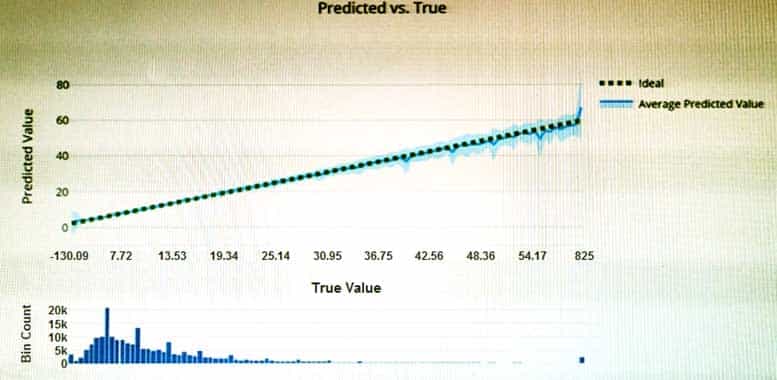
AI-900 Part 02 Q04 015 Which type of model is the chart used to evaluate?
- classification
- regression
- clustering
Explanation:
What is a Predicted vs. True chart?
Predicted vs. True shows the relationship between a predicted value and its correlating true value for a regression problem. This graph can be used to measure performance of a model as the closer to the y=x line the predicted values are, the better the accuracy of a predictive model. -
Which type of machine learning should you use to predict the number of gift cards that will be sold next month?
- classification
- regression
- clustering
Explanation:
In the most basic sense, regression refers to prediction of a numeric target.Linear regression attempts to establish a linear relationship between one or more independent variables and a numeric outcome, or dependent variable.
You use this module to define a linear regression method, and then train a model using a labeled dataset. The trained model can then be used to make predictions.
-
You have a dataset that contains information about taxi journeys that occurred during a given period.
You need to train a model to predict the fare of a taxi journey.
What should you use as a feature?
- the number of taxi journeys in the dataset
- the trip distance of individual taxi journeys
- the fare of individual taxi journeys
- the trip ID of individual taxi journeys
Explanation:
The label is the column you want to predict. The identified Featuresare the inputs you give the model to predict the Label.Example:
The provided data set contains the following columns:vendor_id: The ID of the taxi vendor is a feature.
rate_code: The rate type of the taxi trip is a feature.
passenger_count: The number of passengers on the trip is a feature.
trip_time_in_secs: The amount of time the trip took. You want to predict the fare of the trip before the trip is completed. At that moment, you don’t know how long the trip would take. Thus, the trip time is not a feature and you’ll exclude this column from the model.
trip_distance: The distance of the trip is a feature.
payment_type: The payment method (cash or credit card) is a feature.
fare_amount: The total taxi fare paid is the label. -
You need to predict the sea level in meters for the next 10 years.
Which type of machine learning should you use?
- classification
- regression
- clustering
Explanation:
In the most basic sense, regression refers to prediction of a numeric target.Linear regression attempts to establish a linear relationship between one or more independent variables and a numeric outcome, or dependent variable.
You use this module to define a linear regression method, and then train a model using a labeled dataset. The trained model can then be used to make predictions.
-
HOTSPOT
For each of the following statements, select Yes if the statement is true. Otherwise, select No.
NOTE: Each correct selection is worth one point.
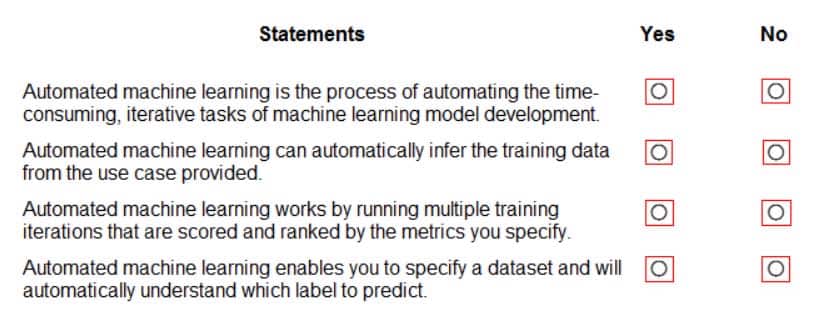
AI-900 Part 02 Q08 016 Question 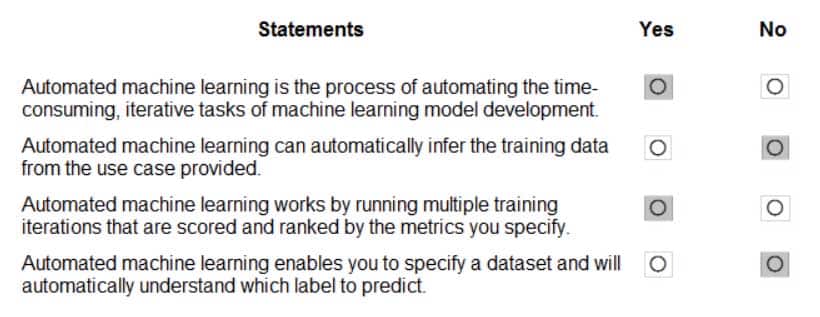
AI-900 Part 02 Q08 016 Answer Explanation:
Box 1: Yes
Automated machine learning, also referred to as automated ML or AutoML, is the process of automating the time consuming, iterative tasks of machine learning model development. It allows data scientists, analysts, and developers to build ML models with high scale, efficiency, and productivity all while sustaining model quality.Box 2: No
Box 3: Yes
During training, Azure Machine Learning creates a number of pipelines in parallel that try different algorithms and parameters for you. The service iterates through ML algorithms paired with feature selections, where each iteration produces a model with a training score. The higher the score, the better the model is considered to “fit” your data. It will stop once it hits the exit criteria defined in the experiment.Box 4: No
Apply automated ML when you want Azure Machine Learning to train and tune a model for you using the target metric you specify.
The label is the column you want to predict. -
HOTSPOT
To complete the sentence, select the appropriate option in the answer area.

AI-900 Part 02 Q09 017 Question 
AI-900 Part 02 Q09 017 Answer Explanation:
Two-class classification provides the answer to simple two-choice questions such as Yes/No or True/False.
-
HOTSPOT
For each of the following statements, select Yes if the statement is true. Otherwise, select No.
NOTE: Each correct selection is worth one point.

AI-900 Part 02 Q10 018 Question 
AI-900 Part 02 Q10 018 Answer Explanation:
Box 1: Yes
In machine learning, if you have labeled data, that means your data is marked up, or annotated, to show the target, which is the answer you want your machine learning model to predict.
In general, data labeling can refer to tasks that include data tagging, annotation, classification, moderation, transcription, or processing.Box 2: No
Box 3: No
Accuracy is simply the proportion of correctly classified instances. It is usually the first metric you look at when evaluating a classifier. However, when the test data is unbalanced (where most of the instances belong to one of the classes), or you are more interested in the performance on either one of the classes, accuracy doesn’t really capture the effectiveness of a classifier. -
Which service should you use to extract text, key/value pairs, and table data automatically from scanned documents?
- Form Recognizer
- Text Analytics
- Ink Recognizer
- Custom Vision
Explanation:
Accelerate your business processes by automating information extraction. Form Recognizer applies advanced machine learning to accurately extract text, key/value pairs, and tables from documents. With just a few samples, Form Recognizer tailors its understanding to your documents, both on-premises and in the cloud. Turn forms into usable data at a fraction of the time and cost, so you can focus more time acting on the information rather than compiling it. -
HOTSPOT
To complete the sentence, select the appropriate option in the answer area.

AI-900 Part 02 Q12 019 Question 
AI-900 Part 02 Q12 019 Answer Explanation:
Accelerate your business processes by automating information extraction. Form Recognizer applies advanced machine learning to accurately extract text, key/value pairs, and tables from documents. With just a few samples, Form Recognizer tailors its understanding to your documents, both on-premises and in the cloud. Turn forms into usable data at a fraction of the time and cost, so you can focus more time acting on the information rather than compiling it.
-
You use Azure Machine Learning designer to publish an inference pipeline.
Which two parameters should you use to consume the pipeline? Each correct answer presents part of the solution.
NOTE: Each correct selection is worth one point.
- the model name
- the training endpoint
- the authentication key
- the REST endpoint
Explanation:
You can consume a published pipeline in the Published pipelines page. Select a published pipeline and find the REST endpoint of it.To consume the pipeline, you need:
– The REST endpoint for your service
– The Primary Key for your service -
HOTSPOT
To complete the sentence, select the appropriate option in the answer area.

AI-900 Part 02 Q14 020 Question 
AI-900 Part 02 Q14 020 Answer Explanation:
To perform real-time inferencing, you must deploy a pipeline as a real-time endpoint.
Real-time endpoints must be deployed to an Azure Kubernetes Service cluster. -
HOTSPOT
To complete the sentence, select the appropriate option in the answer area.

AI-900 Part 02 Q15 021 Question 
AI-900 Part 02 Q15 021 Answer Explanation:
In the most basic sense, regression refers to prediction of a numeric target.
Linear regression attempts to establish a linear relationship between one or more independent variables and a numeric outcome, or dependent variable.
You use this module to define a linear regression method, and then train a model using a labeled dataset. The trained model can then be used to make predictions.
Incorrect Answers:
– Classification is a machine learning method that uses data to determine the category, type, or class of an item or row of data.
– Clustering, in machine learning, is a method of grouping data points into similar clusters. It is also called segmentation.Over the years, many clustering algorithms have been developed. Almost all clustering algorithms use the features of individual items to find similar items. For example, you might apply clustering to find similar people by demographics. You might use clustering with text analysis to group sentences with similar topics or sentiment.
-
HOTSPOT
For each of the following statements, select Yes if the statement is true. Otherwise, select No.
NOTE: Each correct selection is worth one point.

AI-900 Part 02 Q16 022 Question 
AI-900 Part 02 Q16 022 Answer Explanation:
Box 1: Yes
Azure Machine Learning designer lets you visually connect datasets and modules on an interactive canvas to create machine learning models.Box 2: Yes
With the designer you can connect the modules to create a pipeline draft.
As you edit a pipeline in the designer, your progress is saved as a pipeline draft.Box 3: No
-
HOTSPOT
You have the following dataset.

AI-900 Part 02 Q17 023 You plan to use the dataset to train a model that will predict the house price categories of houses.
What are Household Income and House Price Category? To answer, select the appropriate option in the answer area.
NOTE: Each correct selection is worth one point.
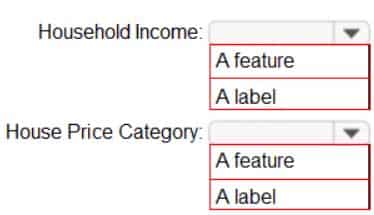
AI-900 Part 02 Q17 024 Question 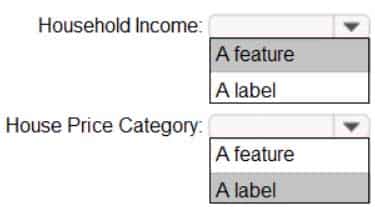
AI-900 Part 02 Q17 024 Answer -
HOTSPOT
To complete the sentence, select the appropriate option in the answer area.

AI-900 Part 02 Q18 025 Question 
AI-900 Part 02 Q18 025 Answer -
HOTSPOT
For each of the following statements, select Yes if the statement is true. Otherwise, select No.
NOTE: Each correct selection is worth one point.

AI-900 Part 02 Q19 026 Question 
AI-900 Part 02 Q19 026 Answer -
A medical research project uses a large anonymized dataset of brain scan images that are categorized into predefined brain haemorrhage types.
You need to use machine learning to support early detection of the different brain haemorrhage types in the images before the images are reviewed by a person.
This is an example of which type of machine learning?
- clustering
- regression
- classification